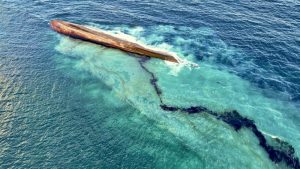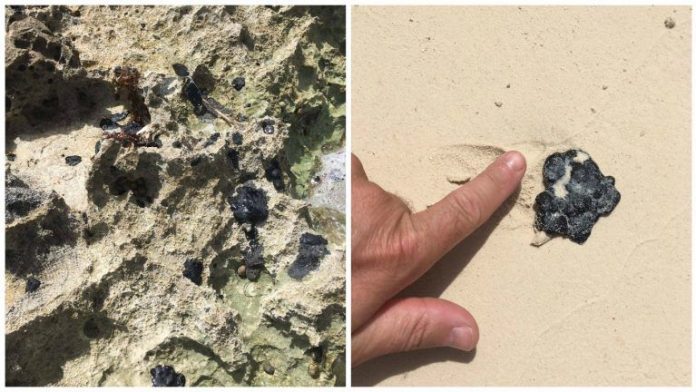On February 7th, National Geographic brought forward that Trinidad & Tobago was experiencing moments of concern in the waters off their southern coast due to a ship of unknown origin that had reportedly left behind a large oil spill in the sea.

The Trinidad & Tobago Coast Guard detected this spill for the first time on that day, located 6 kilometers off the Studley Park coast, according to Farley Augustine, the chief secretary of the Tobago National Assembly, as indicated in a press conference.
From that moment on, barriers were installed to try to stop the spill, which by February 14th had already spread to a 12-kilometer line. One thousand volunteers are trying to protect the areas to isolate the toxic material and evaluate its impact on marine and wildlife, where Prime Minister Keith Rowley pointed out that this is “a national emergency.”
After authorities managed to identify the ship “Gulfstream,” where diving bells were able to see the name on one side of the ship allegedly causing the spill, without giving further details.
As part of the investigation opened for this spill, the Caribbean Community (CARICOM) contacted authorities from Panama and Aruba to try to confirm the origin of this vessel, as well as other boats coming from Panama called “Solo Creed” heading towards Guyana, allegedly towing the “Gulfstream” ship, as indicated by the France24 website.
It was also ensured that “satellite images showed Solo Creed towing an object on February 4th, 2024. The National Coastal Surveillance Radar Center (NCSRC) could use this information to monitor the ship in the waters of Trinidad & Tobago,” according to the text from the Ministry of National Security of Trinidad & Tobago, which also stated that the NCSRC lost radar contact with these two vessels.
On Aruba, on February 26th, the Crisis Management Office (CMO) announced that Aruba had transitioned from yellow to orange code regarding the oil spill incident in Trinidad & Tobago. In this regard, the director of CMO, Rino Hermans, declared to the international press that the Aruban Government had plans to activate a team of 60 people, including first aid personnel and cleaning staff, to address the oil spill situation if it were to reach the Aruban coast, which indeed occurred last Saturday, March 2nd, where tar balls were detected in a known location by CMO. It’s not a very serious situation like in other countries, but it’s necessary to stay alert as Prime Minister Evelyn Wever-Croes stated.
However, it’s possible that they come from the incident in Trinidad and Tobago, it’s also possible that they came via the route of barges between Jamaica and Trinidad through oil tankers, they said. One of the pictures is of the ship in Trinidad & Tobago.
Tar balls are formed when highly viscous crude interacts with water; the spill from Tobago cannot be the origin of these tar balls. They’re more likely from illegal oil discharge near the coast of Aruba. Possibly from ships sailing to Venezuela to carry or seek crude. Another possibility is an oil spill from Lake Maracaibo, where oil spills are very common due to all facilities and pipelines being in poor condition and constant leakage, as reported by Venezuelan media, which also raises the alarm that spills persist and complicate the situation in this area.
Through a press release, CMO informed the community that from the moment they received reports about the oil reaching the coast of Bonaire, Aruba intensified its alert level to Orange Code, and an Incident Management Team was immediately established following the oil spill control plan (OILIE).
Aruba intensified its efforts to scout the coast by dividing it into five sectors, where intensive exploration is taking place by different agencies such as DNM, FPNA, DOW, hotels under the leadership of ATA under Cluster 8, and the Harbor Master.
They also pointed out that tar balls can be expected in the coming weeks, but recent scouting and information, as well as the Rapid EMS Mapping to outline the waiting impact area, suggest that most of the stains have passed Aruba. However, there may still be tar balls coming ashore in the next few days; CMO calls on the population to report any oil stains they may see, even if they are located in remote areas. To report this, you can send an email to: cmo@crisis.aw
Immediate cleaning actions will take place if the patch of tar balls is located in areas where the public lands, and also if it is located where turtles lay eggs or use them for nesting. However, all tar patches on cliffs will remain if they pose no risk to humans or animals, as informed by CMO.
The Regional Emergency, Information, and Training Center for Marine Pollution in the Caribbean (Rac-Rempeitc Caribbean) is one of the four Regional Activity Centers of the Caribbean Environmental Program CAR/PAP established in 1995. It counts on experts in the field affiliated voluntarily to the signatory states of the Cartagena Convention Oil Spill Protocol of the United Nations via the United Nations Environmental Program regional office in Kingston, Jamaica. Aruba is also a signatory to this treaty and its protocols.




















